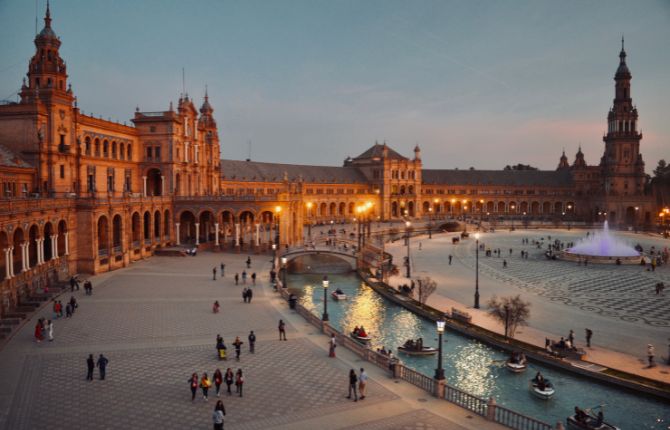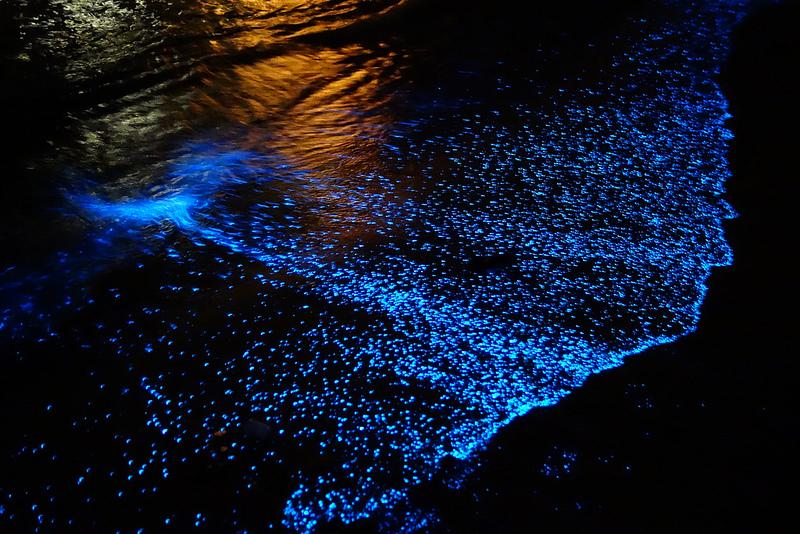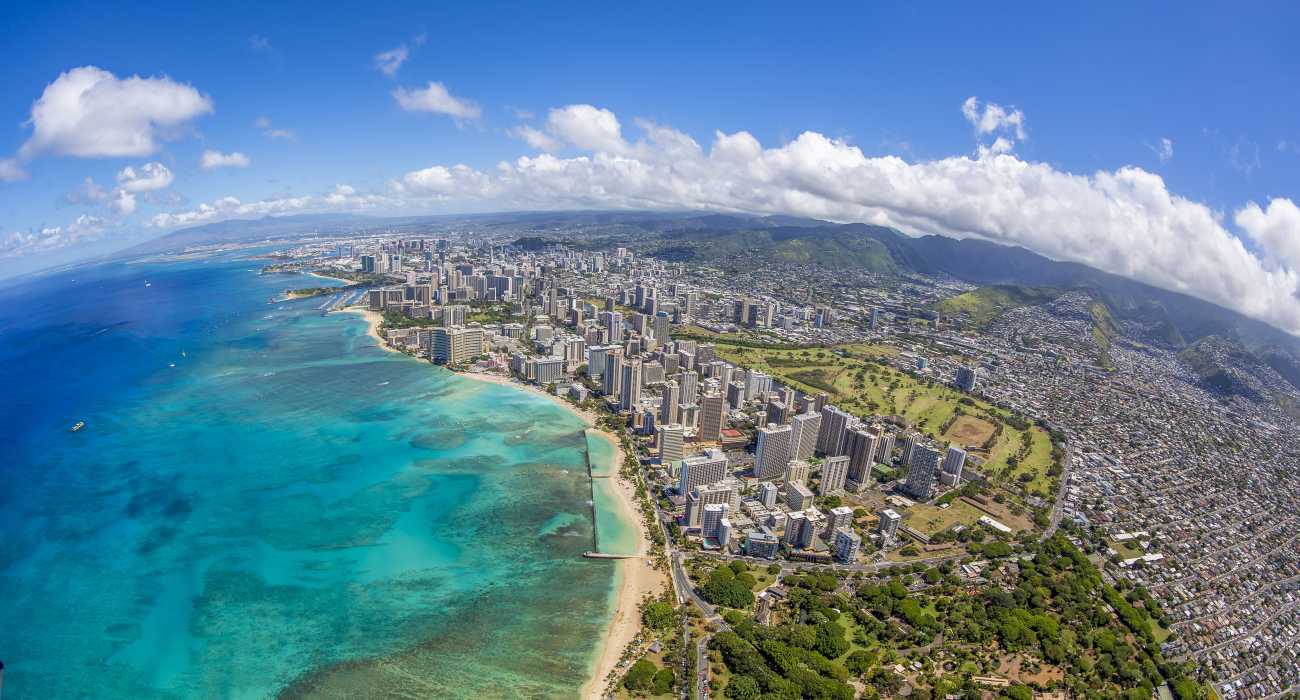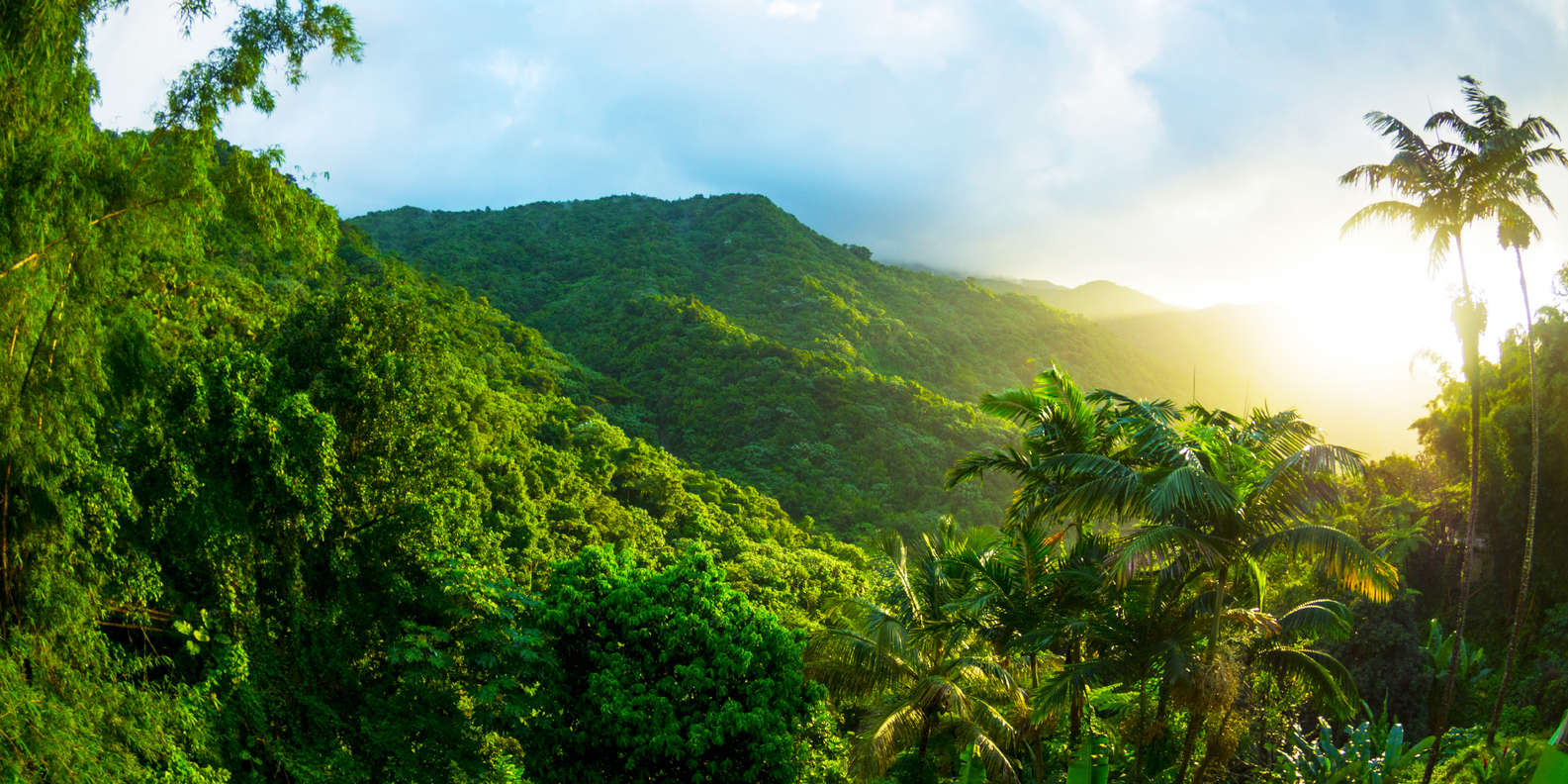Looking for the best things to do in Seville, Spain?? Here’s the list with all the travel information you need to plan a family tour.
Seville Cathedral, La Giralda, Royal Alcazar of Seville, Parque de Mara Luisa, and cultural festivals are the most popular tourist attractions in Seville.
Let’s discover the complete list of things to do in this beautiful city in Spain.
1. Things to Do in Seville: Seville Cathedral (Catedral de Sevilla)
The soaring 12th-century spire of Seville Cathedral is an impressive sight. And it is the largest Gothic Cathedral in the world. This monument also boasts a crypt where the bones of saints are preserved.
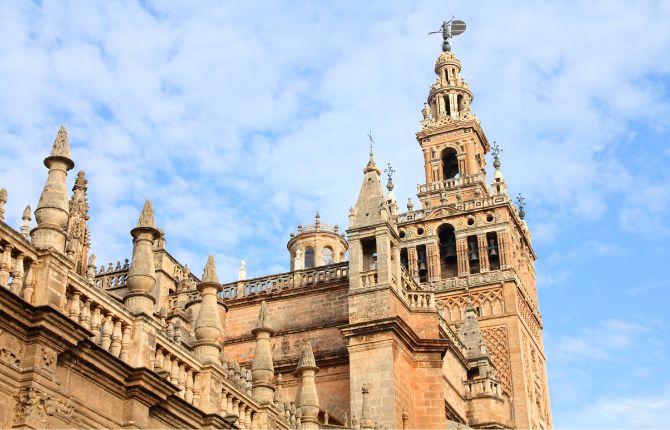
The crypt is a fascinating place because it is home to the city’s most important relics.
Aside from the spire, the Cathedral has numerous other important religious sites. To see the entire structure, take the time to explore the church’s many crypts and apses.
Inside the Cathedral, you’ll find a 117-meter long, 76-meter-wide, and 40-meter-high ceiling. This rectangular floor plan is accentuated by its five-aisled interior, which includes 75 stained-glass windows from the sixteenth to the nineteenth centuries.
The Cathedral also features a Gothic choir with ornate stalls. You can also visit the Reja, the tower that encloses the apse.
This impressive Cathedral is listed as a UNESCO World Heritage Site as well. Its bell tower (La Giralda), Main Chapel (Capilla Mayor), Patio of Orange Trees (Patio de Los Naranjos), 16th-century chamber (Sacristía Mayor), and the library (Biblioteca Colombina) are the most highlighted areas in the Seville Cathedral.
Seville Cathedral is also home to the remains of Christopher Columbus, who was buried in the city in 1598. Only one-fifth of Columbus’ body is preserved in the Seville Cathedral’s coffin.
The rest of his remains are buried in the Cathedral’s crypt, which is a fascinating and evocative setting. The Cathedral also contains the tombs of Christopher Columbus and Ferdinand Columbus.
Whether you’re Catholic or not, you’ll definitely find a calm place to worship in Seville.
While in Seville, you might as well check out the city’s Alcazar. This historic royal palace, the oldest royal palace in Europe, is an excellent example of Mudejar art. It was added to the UNESCO World Heritage List in 1987.
The Alcazar was originally built as a palace for the king of Castile, but it’s been renovated to reflect the modern city. It’s a magnificent place and worth exploring.
Address: Av. de la Constitución, s/n, 41004 Sevilla, Spain Phone: +34 902 09 96 92
2. Things to Do in Seville: La Giralda
If you plan to visit Seville, Spain, you should see the Cathedral of Seville. Seville Cathedral was originally a mosque, but Christians conquered the city in 1401 and rebuilt it in the 15th century.
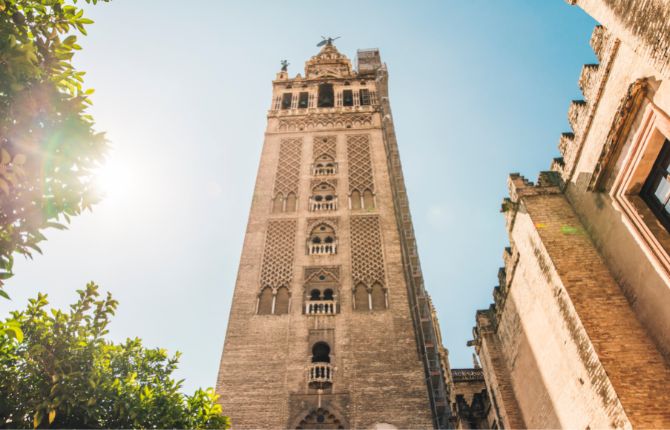
The Gothic-styled Cathedral has imposing entrances and architectural elements. The Capilla Mayor, or gold altarpiece, is one of the Cathedral’s most notable features.
The Cathedral also contains religious works of art and the tombs of Spanish royalty. Christopher Columbus is also buried in this Cathedral.
Among Seville Cathedral’s other attractions, the octagonal-shaped bell tower of La Giralda is a must-see. It was originally the minaret of the mosque built by Moorish rulers of the Almohad dynasty during the 12th century. This 93-meter-high bell tower is still an iconic landmark in Seville.
If you’re traveling with children, consider visiting the Santa Cruz neighborhood, where many cafes, boutiques, and restaurants exist. Also, don’t miss out on the Torre del Oro, topped with a golden scepter.
The city’s skyline reflects the tower’s historic role as a beacon. It has been the focal point of the city’s history, and its bells have been the focal point of city life.
The Giralda has presided over the city’s skyline. In fact, it was the tallest structure in the city, and its fusion of architecture and civilization has given it an unparalleled presence in the city.
If you’re traveling with children, consider visiting the Santa Cruz neighborhood, where many cafes, boutiques, and restaurants exist. Also, don’t miss out on the Torre del Oro, topped with a golden scepter.
You’ll also want to visit the Torro del Oro, or “Tower of Gold.” This watch tower stood 36 meters tall and was built in the Moorish style in the 12th century. It was created when Seville was booming with trade overseas, and the city gained a great deal of wealth.
It has a rich history. Prisoners were once held here. There is no shortage of legends about the tower, but its mere presence is enough to make it worth a visit.
Address: Av. de la Constitución, s/n, 41004 Sevilla, Spain Phone: +34 902 09 96 92
3. Royal Alcázar of Seville
The Royal Alcazar of Seville, or al-Qasr al-Muriq, is an impressive Spanish palace. Built during the early 15th century for the Christian king Peter of Castile, it was a model of Islamic architecture.
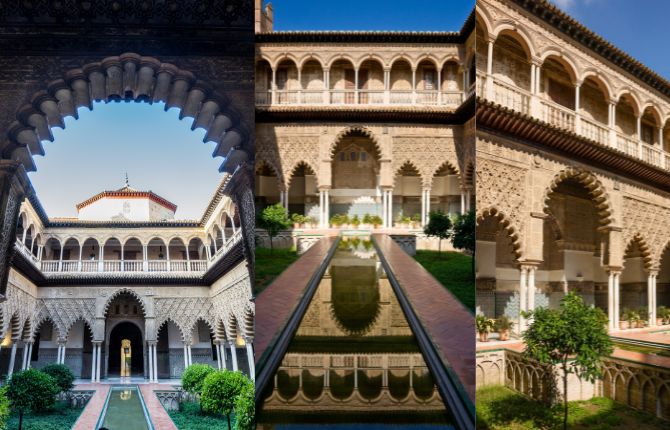
The Royal Alcazar of Seville is one of the city’s most beautiful examples of Mudejar architecture. Therefore, it is listed as UNESCO World Heritage Site.
But, after the Christian Reconquest, it was renovated by adding Gothic and Arabic details in the 14th century.
It features incredible details and a beautiful courtyard, Patio de las Doncellas, constructed between 1369 and 1379. And also, the Hall of the Ambassadors (Salón de Embajadores) features a splendid domed ceiling and other impressive details.
On the other hand, do not miss the elegant grounds of Los Jardines del Alcázar. You may see fragrant orange trees, leafy palms, and roses.
A visit to this palace is one of the highlights of a visit to Seville. Whether you tour the palace or just take pictures of the fantastic architecture, the Royal Alcazar of Seville is well worth your time.
It is home to the Spanish royal family when in Seville. It boasts walled gardens, intricate plasterwork, and a spectacular vaulted cistern. It has also been a filming location for many films, including Game of Thrones and Lawrence of Arabia.
And with so much to see, it’s a must-see destination for any Seville vacation.
Address: Patio de Banderas, s/n, 41004 Sevilla, Spain Phone: +34 954 50 23 24
4. Plaza de España
The Plaza de España is located in the Parque de María Luisa, in Seville, Spain. It is a plaza built in 1928 for the world’s fair, Ibero-American Exposition in 1929.
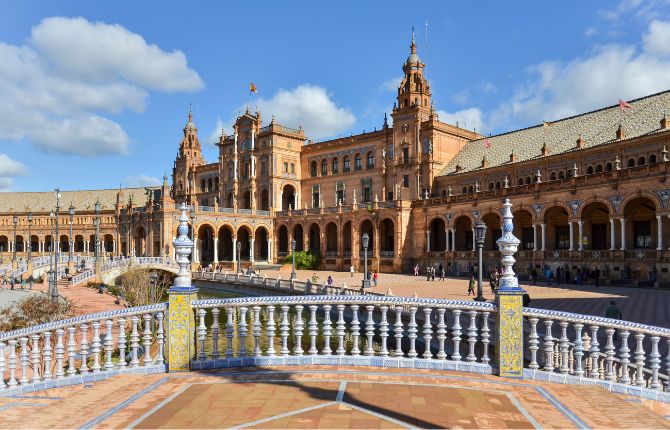
If you had seen it in the sunshine, the gold tiles would have been magnificent!
The Plaza de España represents various architectural styles, including Renaissance Revival, Baroque Revival, and Moorish Revival styles of Spanish.
There’s a lovely canal running through this 50,000-square-meter plaza, and balconies of a Neo-Moorish building surround it. Footbridges are there over the canal. You can rent a boat and paddle on the canal while seeing the surrounding beauty.
That’s why the Plaza de España calls the “Venice of Seville.”
There are also several other places to visit in the area. You must not miss seeing the Seville Cathedral listed on the UNESCO World Heritage List. If you go to the top of the building, you can watch the sun setting over the city.
Another great place to visit is the Museum of Arts and Traditions, which displays some beautiful works. This museum was once a convent, and you can see many paintings on display.
Address: Av. Isabel la Católica, 41004 Sevilla, Spain
5. Parque de María Luisa
If you are looking for a beautiful park in Seville, you should visit the Parque de María Luisa. This large, green space runs along the Guadalquivir River.
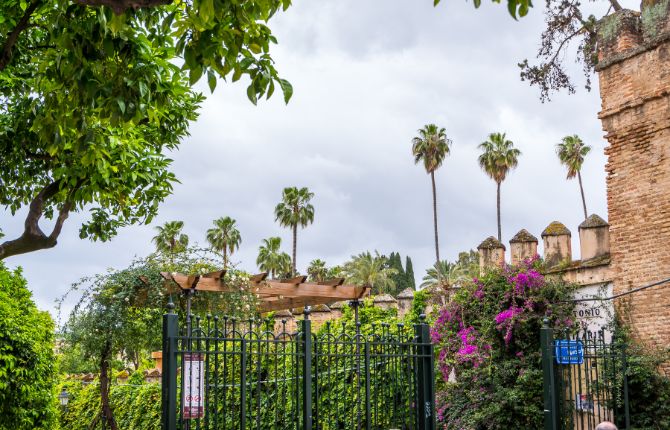
It is Seville’s main green space. If you enjoy walking, cycling, or just lounging around, this is the place to go. But don’t get too carried away: you can find plenty of other places to visit while in Seville.
The most famous park in Seville is Maria Luisa Park, which was once a private garden. The park was named after Infanta Maria Luisa Fernanda de Borbon, Duchess of Montpensier.
It was designed by French Engineer Jean-Claude Nicolas Forestier, who had previously worked as a forest conservator in Paris. He gave the park a romantic flair, taking inspiration from gardens in the area.
In the park, you’ll find two museums: the Museum of Popular Arts and Traditions and the Archeological Museum of Seville. Both are free and open all day.
The park’s open hours make it an ideal place for a stroll in the evening. As the park is in the center of Seville, there’s ample parking available, but it’s recommended to take public transportation if possible.
You can also buy souvenirs or antiques at the Mercadillo El Jueves, one of the oldest markets in Europe. The eclectic market allows you to browse the stalls, find souvenirs, and buy unique pieces. If you’re in the mood for some shopping, you can also visit the Mercado de Feria in the area. It’s a great place to shop and people-watch.
Address: P.º de las Delicias, s/n, 41013 Sevilla, Spain Phone: +34 955 47 32 32
6. Santa Cruz, Seville
Santa Cruz considers the tourist heart of Seville. The city’s Gothic landmark, the Seville Cathedral located in Santa Cruz, provided magnificent views from the Giralda bell tower.
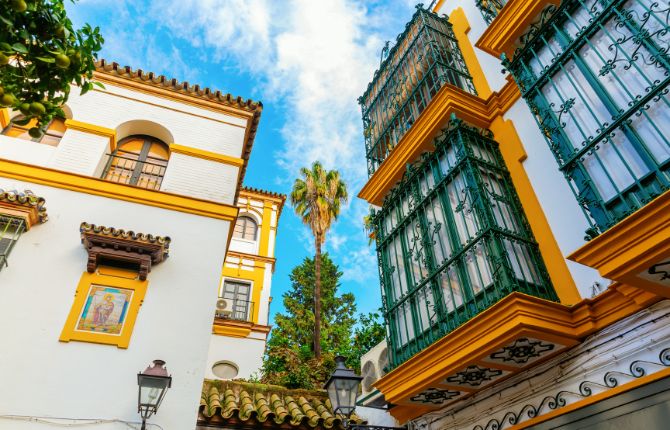
You can also explore the Real Alcázar, a Moorish-Renaissance palace backed by lush gardens. Try Iberian ham and octopus at a tapas bar on Calle Mateos Gago for lunch.
This historic center also features a vibrant old Jewish neighborhood dotted with souvenir shops and orange-tree-lined squares.
The Barrio de Santa Cruz or Seville old town is located between the Royal Alcázar and Catedral de Sevilla. You can see an authentic old-world atmosphere in this neighborhood.
There is an impressive museum in Santa Cruz that you should not miss. It is Hospital los Venerables. It features remarkable artworks of the famous painter Diego Velázquez.
The city’s cultural heritage is richly represented in the festival Semana Santa. Seville is home to the largest and most renowned of these celebrations. From traditional fiestas to modern arts and architecture, this celebration will surely delight all senses.
Seville’s rich history makes it a must-see for visitors. There’s no better time to celebrate this traditional festival.
7. Triana, Seville (Barrio de Triana)
If you are looking for a place to have fun in Seville but aren’t sure where to start, check out Triana.
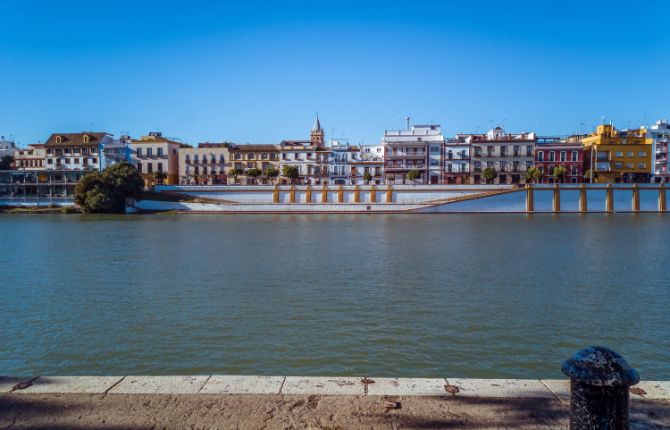
This lively neighborhood is a great place to find a variety of local crafts, food, and activities. While you’re here, check out the markets in Mercado de Triana, near the Puente de Isabel II bridge. Here you’ll find food stalls and small eateries aplenty.
Further into the neighborhood, walk down Calle Betis, lined with restaurants, bars, and even flamenco venues. Ceramic shops and museums are clustered around the Centro de la Cerámica Triana, where you’ll find a museum devoted to ceramics.
Before the city walls were built, Triana was an area outside the city’s walls, where gypsies, blacksmiths, and other unscrupulous people lived.
The streets in Triana were infamous for their dangers and were filled with gypsies and outcasts. This neighborhood had more fire-related incidents than any other part of the city.
This area became so notorious for its fire risk that it is still home to several museums dedicated to the art of ceramics.
Then, it became a famous tourist destination in Seville, Spain.
The Puente de Triana in Seville is an iconic piece of architecture. The bridge, which spans the River Guadalquivir, offers a panoramic view of the city.
Located on Calle Betis, it’s close to the Maestranza bullring and the Torre del Oro. Visitors can enjoy a variety of food and drink on its colorful terraces. This area also contains the Castillo San Jorge, where gypsies lived in the area.
8. Seville Museum of Fine Arts
The Seville Museum of Fine Arts offers a variety of tours that cover a range of subjects. Visitors should always be respectful of the artwork and refrain from touching it.
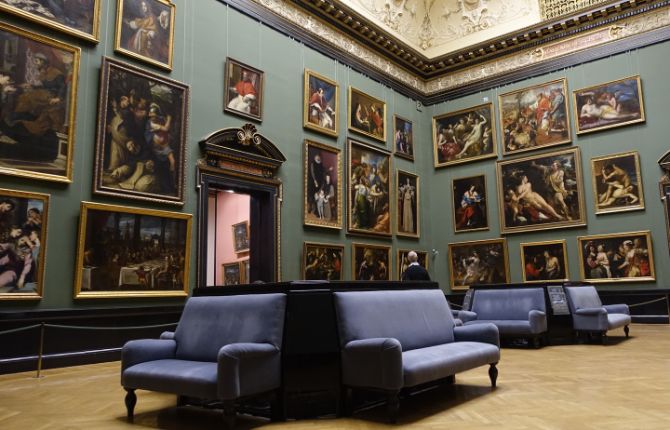
This museum features an impressive collection of Spanish visual arts representing various eras, including the medieval period and the early 20th century.
While taking photographs, they should not use flash photography as art has a high value and can quickly deteriorate due to its antiquity.
For ease of access, there are ramps and lifts available. In addition, children are welcome to participate in the museum’s special programs.
Located in an old convent, the Seville Museum of Fine Art features works from the Gothic and Renaissance periods and the 20th century.
The museum’s collection has been built up over time through private donations and disentailed ecclesiastical assets. Currently, there are several exhibitions in the museum.
The Murillo and Sevillian schools are particularly impressive, as are works by the great Zurbaran.
You can visit the Museum of Fine Arts of Seville during daylight hours and avoid rush hour. However, during the night, the Museum is closed.
You can enjoy a tapas bar while listening to live music in the morning.
Several interactive activities help kids explore the museum’s artwork.
You can also enjoy a special show of Basque paintings during your visit. The museum is free to visit, and admission is free for those under three years old.
The Seville Museum of Fine Arts was originally a convent in the Mudejar style. The Order of Blessed Virgin Mary of Mercy has founded in 1612, and the building is a mixture of Christian and Muslim styles.
The museum’s collection ranges from the Roman Empire to the Middle Age (15th century). Its Renaissance Pavillion was a permanent pavilion at the 1929 Ibero-American Exposition.
In the early 19th century, it was converted into a museum and opened its doors to the public. Since then, it has undergone several renovations.
Address: Pl. del Museo, 9, 41001 Sevilla, Spain Phone: +34 954 78 64 98
9. Right Bank of the Guadalquivir River
If you’re planning a trip to Seville, you should make sure to visit the Right Bank of the city’s mighty Guadalquivir River.
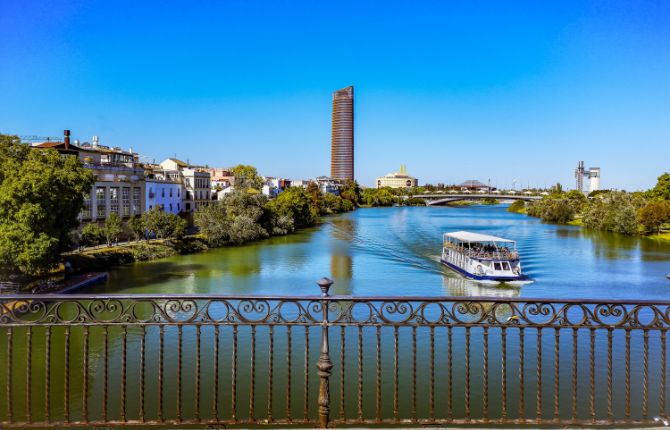
The beautiful park on the right bank is a lovely place to spend some quiet time contemplating the city’s sights. This botanical garden is also worth visiting and is an excellent place to people-watch.
Here are several attractive places to visit on the Right Bank of Guadalquivir River.
Alameda: This is one of Seville’s most famous and hip districts. It is often compared to Barcelona’s El Raval or London’s Soho. It’s a pedestrian street brimming with hip bars and alternative shops. Seville’s famous nightlife is centered around this area. It is also home to several outdoor artisan markets.
The Catedral de Santa Maria de la Sede: Built between the 15th and 16th centuries, the Cathedral of Santa Maria de la Soledad marries Moorish and Gothic architecture. Its golden-flecked cupola features a mural of Ferdinand III. The Cathedral is also home to a stunning 13th-century fresco of the Virgen de la Antigua.
Triana: Located on the Left Bank of the Guadalquivir, the Triana neighborhoods offer a completely different atmosphere than the city center. These neighborhoods are brimming with Sevillian culture and are associated with flamenco, painted ceramics, and azulejos decorative tiles. A visit to this vibrant area of Seville will leave you feeling satisfied and inspired.
10. Iglesia Colegial del Divino Salvador
The Iglesia Colegial del Dios Salvador in Seville is the second most important church in the city.
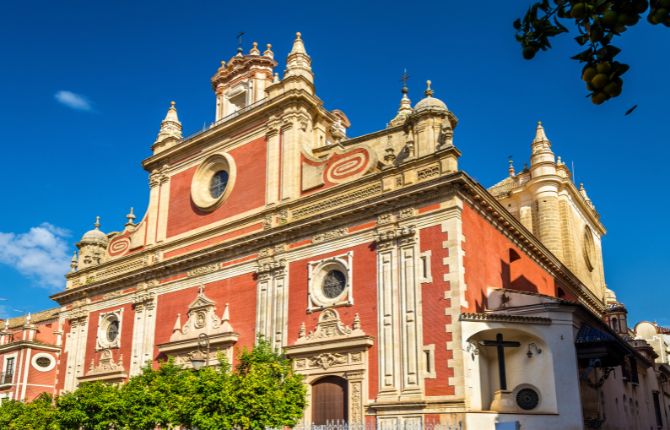
It stands in the Plaza del Salvador and is the second-largest church in Seville, after the Cathedral.
After restoration, the Cathedral was stripped of its parish status, but it still serves as a religious site. The church’s patio contains vestiges from the Roman and Visigoth eras.
The Iglesia Colegial del Dios Salvador is a beautiful example of baroque architecture. Gold statues adorn the walls. It takes approximately an hour to explore.
A trip to Seville would be incomplete without a visit to the Iglesia Colegial del Dios is a must. Seville’s fascinating historical center is home to the world’s largest Gothic Cathedral.
You can tour the Cathedral’s roof, but you’ll need a different ticket. The top of the Cathedral is worth the visit, and the views of Seville are absolutely breathtaking!
A stroll along the Guadalquivir River is an excellent free activity to do while in the city. Once you’ve explored the historical sights of Seville, you’ll want to explore the surrounding neighborhoods.
Another famous sight in Seville is the Bullring. Located just outside the city center, the Bullring has a museum dedicated to its history and place in Spain. There are guided tours that take about an hour.
The Aquarium of Seville is a great place to visit if you’re visiting with children. The Aquarium features a variety of exotic fish and even sharks.
Address: Pl. del Salvador, 3, 41004 Sevilla, Spain Phone: +34 954 21 16 79
11. Museum of Popular Arts and Traditions, Seville
There are many things to see in Seville, and the Museum of Popular Arts and Traditions is definitely one of them.
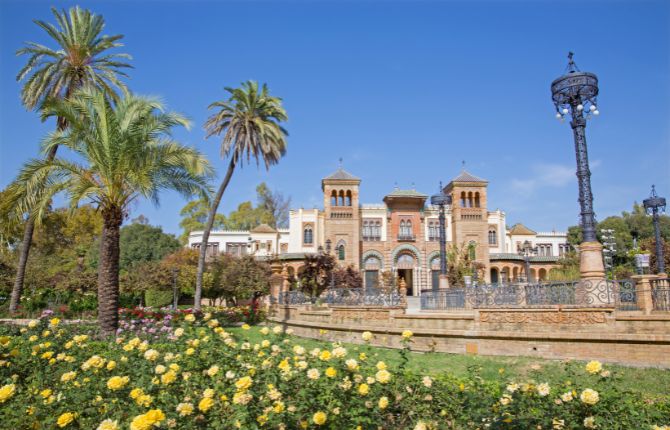
The building itself is beautiful, with whitewashed buildings and lovely shops. The Museum of Popular Arts and Traditions features various displays from local food to famous monuments in each province.
The museum also features busts of famous national figures. The interior is a Museo for the arts and crafts lovers, with exhibits highlighting the food and tradition of the region.
The museum is also home to the Caixaforum museum, which promotes local culture worldwide. The museum is part of the Torre de Seville and hosts various events that encourage Seville’s history and culture.
The museum is open to the public during certain times, and admission is free. Once you arrive, you can enjoy the museum’s unique atmosphere while sipping a glass of Seville wine.
The Museum of Fine Arts is another place you should visit while in Seville. The museum features mainly Spanish art, but there are also some pieces from the local region.
Murillo, an artist famous for his dreamy paintings of Madonna and Child, is featured prominently. This museum is in a former convent and features an elegantly painted chapel.
While visiting the museum, make sure to spend some time admiring the cathedral-like ceiling and imperial stairway.
Address: Pl. América, 3, 41013 Sevilla, Spain Phone: +34 955 03 53 25
12. Things to Do in Seville: Semana Santa celebration in Seville
Don’t skip the Semana Santa celebration if you’re planning a trip to Spain. This annual religious celebration is one of the most popular and well-known in the country.
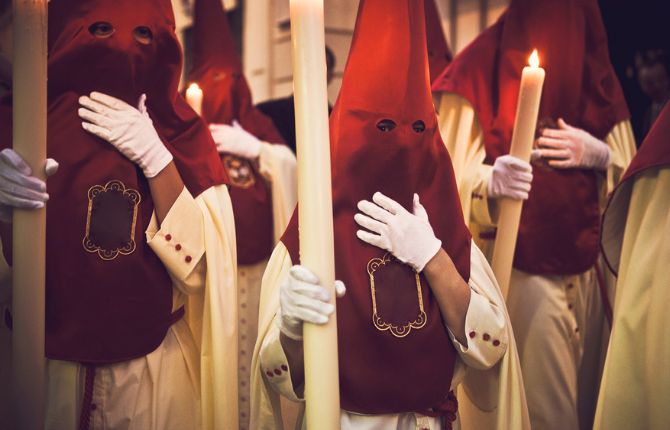
The festival of Semana Santa takes place during the week leading up to Easter Sunday. In fact, it’s estimated that Seville attracts up to 50,000 people during Holy Week.
Here are some tips for visiting Seville during Semana Santa:
Palm Sunday marks the start of the Holy Week, and families participate in the festivities by dressing up and promenading through the streets with olive and palm branches.
This tradition is celebrated in other churches throughout the city as well. In Seville, many religious brotherhoods, each with their own set of traditions, take care of the venerable floats. The statues of Christ and Mary bring great emotion to the crowd.
During Semana Santa, the center streets become thronged with people. The hours of the bars in Seville are extended to accommodate the crowd.
The enthusiasm surrounding the celebration is palpable. In addition, visitors can experience the city’s cofradía, brotherhoods of local churches.
The festivities last for a week. You can attend a flamenco procession, participate in a nativity play, or simply sit back and soak in the atmosphere.
The main procession route during the Semana Santa festival follows the Carrera Oficial. The Carrera Oficial has evolved since its original creation in the sixteenth century.
It is the backbone of today’s route. The final major change came in the 17th century when the various cofradía began dividing themselves into modern routes.
So, whether you’re looking for an intimate celebration or a fun-filled festival, Seville is sure to have something to offer.
13. Seville Fair (Feria de Abril)
In the center of Seville, the Recinto turns into a mini-city during the Seville Fair in Spain.
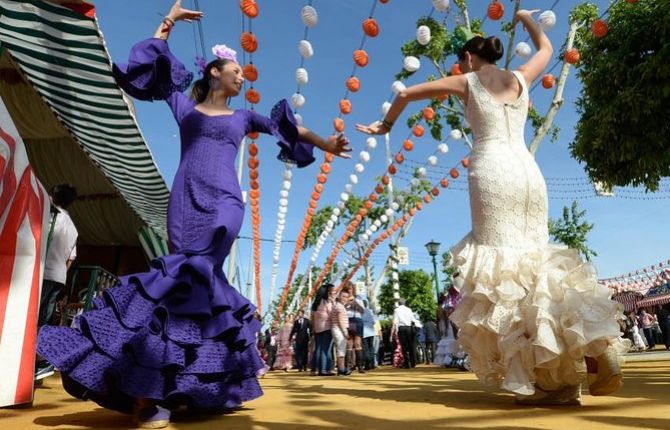
The Seville Fair is a week-long festival that’s celebrated by locals and tourists alike. The city’s April Fair, or Feria de Abril, started out as a cattle fair but has evolved into an international event.
More than a thousand tents are put up during this week-long festival to celebrate the arrival of spring. While similar fairs are held all over Spain during early spring, the Seville Fair reigns supreme.
The April fair is celebrated with a week of dancing, eating, drinking, and socializing. On Sunday, Seville society parades around the fairground on horseback. The festivities continue until the wee hours of the morning.
There’s a bullfight and a fanning competition, so make sure to pack plenty of cash! You’ll want to take your camera and capture some of these amazing scenes! The Seville April Fair is a must-see for the entire year.
The springtime atmosphere of the fair is especially apt in Seville, where the city is most beautiful in the springtime.
Two weeks after the Semana Santa holiday, the city celebrates the Feria de April or the Seville Fair. This week-long event is a colorful and bustling extravaganza located in the southwestern part of Seville.
Hundreds of floats and dozens of colorful tents are erected in the recinto ferial (fairground) and filled with Seville’s.
The streets and casetas are clearly marked and named, making it impossible to get lost. You’ll find an amusement park in Calle del Infierno, usually packed with kids. The famous big wheel is also located in this area.
This is the event for you if you’re looking for a fun-filled and memorable fair.
14. Museo del Baile Flamenco (Museo del Baile Flamenco)
If you plan to travel to Seville, you should check out Museo del Baile Flamenca. This 18th-century building houses a museum dedicated to the art of flamenco dancing.
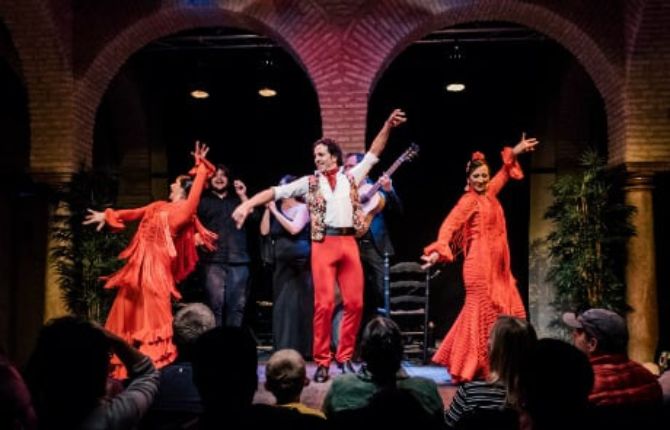
The museum offers live performances of this unique form of dance. In addition to the exhibits, you can see live flamenco shows. You can learn about the art form and even try it yourself here.
The museum has several exhibits pertaining to flamenco, including the modern style. You can also view film props and costumes from classic flamenco films, such as the famous fight scene from the movie “Siempre te llegado” or ‘Baile Flamenco.’
You can even take lessons from the museum’s staff in seven languages.
You can also enjoy a Flamenco show at the Museo del Baile Flamenc in Seville. The show is intimate and an excellent place to catch a performance of this unique dance style.
You can also opt for VIP seats to enjoy the show with a glass of bubbly.
The Catedral de Seville is a UNESCO World Heritage Site and the first flamenco museum in the world. Founded in the 18th century, it stands on the pillars of a Roman temple.
The museum exhibits the dance’s history through interactive displays and fashion. It also has a courtyard where flamenco shows are held. Flamenco is an integral part of Seville’s culture, and you can see it up close and personal.
If you want to plan your own Seville vacation, creating a self-guided tour of the city is easy. You can choose which attractions to visit and begin your time at your hotel.
Address: C. Manuel Rojas Marcos, 3, 41004 Sevilla, Spain Phone: +34 954 34 03 11
15. Italica, Seville
The first Roman settlement in Spain was in the town of Italica in southern Spain. Founded by the Roman general Scipio, this city thrived under Hadrian and Trajan.
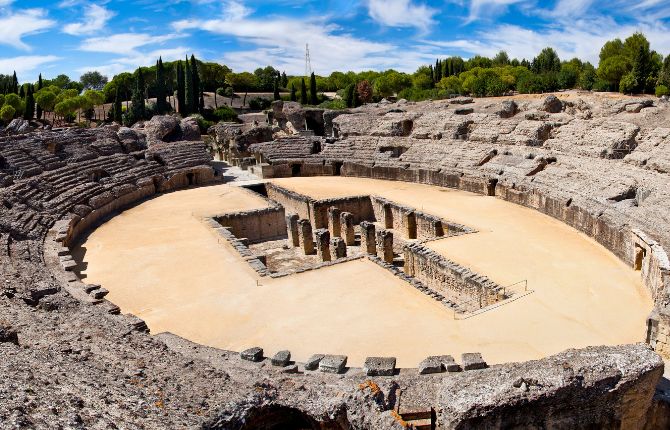
A well-preserved relic of this site can be seen in Santiponce, today’s town, which lies atop the pre-Roman Iberian settlement. You can explore the ruins by taking a guided tour.
You can travel to Italica in Seville by bus. The M-172A Damas bus departs from the Plaza de Armas. The archaeological park is 10 km outside the city center. Shops and restaurants surround the park.
The Italica ruins feature a collection of mosaic floors and streets. The mosaic floors in the villas are of high quality. The main villas include the House of Neptune, Rodeo, Hylas, and Planetarium, as well as the Templo of Trajan.
Several finds from the excavations are preserved in the Museo Arqueologico de Seville. These ruins are a must-see for tourists in Seville.
If you want to see the best-preserved Roman ruins in southern Spain, you may want to visit the Italica in Seville. This ancient city is less than ten kilometers away from the city, which makes it a convenient choice for those on a budget.
The city of Seville offers lodging for all budgets, including budget-minded travelers. Most hotels and hostels in Seville are also less expensive than those in other parts of the country.
Also, you can enjoy a delicious meal with your family as you enjoy the sights of the city. This is an ideal trip for families or anyone interested in the Roman past.
16. Plaza de toros de la Real Maestranza de Caballería de Sevilla
A visit to the Plaza of Toros in Seville is a must-do for anyone visiting the city. This historic bullring in Seville is the oldest in Spain and one of the best in the world.
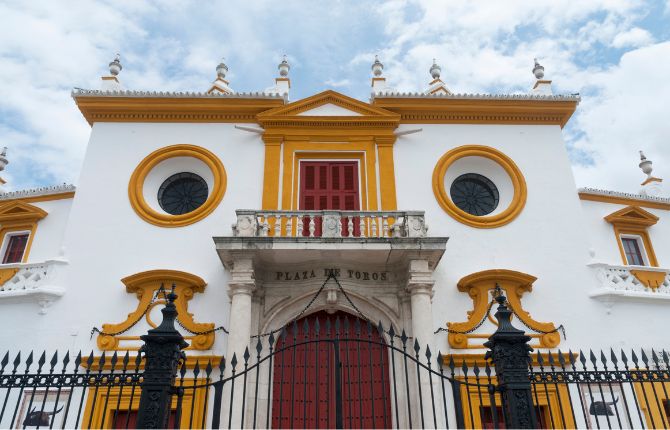
Although many younger Spaniards abhor bullfighting, the ring is a great place to experience the thrill of the corrida.
The Real Maestranza Plaza was built in the first quarter of the nineteenth century and is situated on an elevated hill, known as the Baratillo (the coso).
This project was the first to incorporate a circular oval shape. It has a beautiful setting and is a great place to enjoy a bullfight. It is also home to many locals who dress up in traditional Seville clothing and watch the races.
The Bullring in Seville is one of the most important tourist attractions in the city. This historical bullring is Spain’s oldest bullring and home to one of the most famous bullfighting festivals.
The bullring is also home to a museum where you can learn more about the history of the bullfighting sport. The bullring also holds the Seville April Fair, one of the largest bullfighting events in the world.
The bullring began construction in 1761. The bullring was previously located on Baratillo Hill. The real Maestranza began construction on a stone building in 1761, replacing the temporary wooden bullring.
The construction process lasted about 120 years and included several stages. Despite the challenges, the bullring was completed in 1881. Until then, the Plaza of Toros in Seville was a beautiful place for bullfighting.
Address: P.º de Cristóbal Colón, 12, 41001 Sevilla, Spain Phone: +34 954 21 03 15
17. Casa de Pilatos
The historic palace of Casa de Pilatos in Seville is a stunning example of traditional Andalusian architecture.
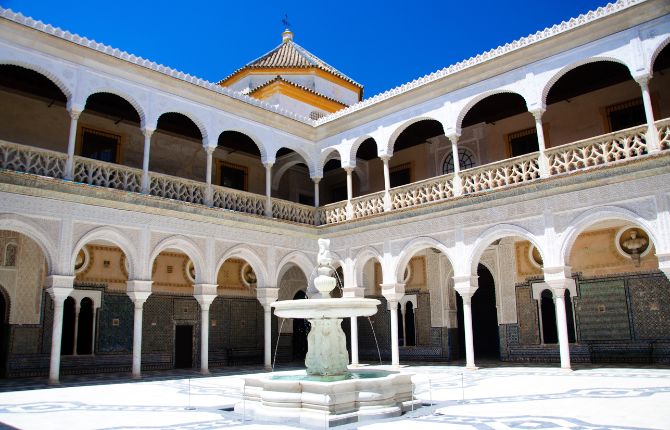
The architecture of the Casa de Pilatos is a fascinating blend of the Spanish Mudejar style and the Italian Renaissance. The building’s courtyard is surrounded by white marble columns and arches, and its walls are covered in multicolored tiles.
The stairway is the first of its kind in Seville, and the dome is reminiscent of the Nasrid Palace in the Alhambra. It is worth a visit just to appreciate the grandeur and architecture of this palatial home.
During the 16th century, Seville was referred to as ‘the new Rome.’ It features a mix of Spanish Mudejar and Renaissance styles, and Gothic elements later on.
The chapel is one of the most fascinating parts of the palace, and the only one in Seville with tile skirting boards.
You should also visit Triana Park, Seville’s largest park. This enticing area was originally built to be the main focus of the 1929 Ibero-American exposition.
It features palm-lined avenues, colorful mosaics, and trickling fountains. The park spans the Guadalquivir river, and is located in the heart of Seville’s Triana neighborhood. Despite its wealth of amenities, it still retains a small-town charm.
Another fascinating site in Seville is the Real Alcazar. This 16th-century palace is a UNESCO World Heritage site. It is built in the Mudejar style, which combines Moorish ornaments with Christian standards.
The gardens are lush and beautifully landscaped, with a water fountain and tall trees providing shade. You will love spending time in the gardens during the warm months. Soak up the ambiance of the Alcazar by walking around the city.
Address: Pl. de Pilatos, 1, 41003 Sevilla, Spain Phone: +34 954 22 52 98
18. Palacio de la Condesa de Lebrija
The family palace, Palacios de la Condesa de Lebrija, is located on the Campana end of Calle Cuna, parallel to Calle Sierpes.
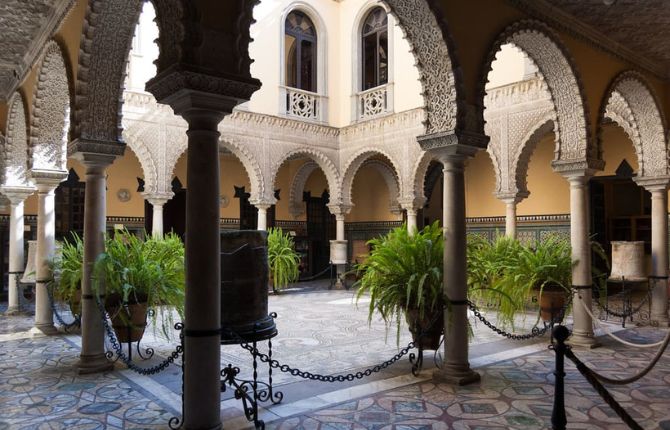
The large wooden doors and discreet stone doorway open onto the courtyard. This typical Sevilleno house has an elegant and spacious patio, which you can explore with a private tour.
Originally a Renaissance-style mansion, the building was remodeled and styled by the Condesa de Lebrija in the 19th century, when she was a keen collector and traveler.
The Countess of Lebrija, Regla Manjon, had a passion for art and spent her life protecting it. Her magnificent palace features a gallery of twelve famous Sevillians, including Diego Velázquez.
Bartolome Esteban Murillo is also included in the gallery of twelve eminent Sevillians. The palace’s enchanting facade and magnificent statues add to the magnificence of the imposing structure.
A visit to this beautiful palace is sure to leave an impression on your visitors. You can sample traditional Spanish dishes at the Bodeguita Romero, such as the montadito de pringa, a sandwich made with pork.
Alternatively, try a tapas restaurant with unusual combinations of dishes. Another great option in Seville is the Canabota, which is known for its seafood and offers a fine selection of sherries and wines. You can also try the traditional Spanish cuisine at Freiduria La Isla.
Address: C. Cuna, 8, 41004 Sevilla, Spain Phone: +34 954 22 78 02
19. Monasterio de Santa Paula
When you visit Seville, don’t miss the Monasterio de Santa Paula. This monastery was built between 1483 and 1489.
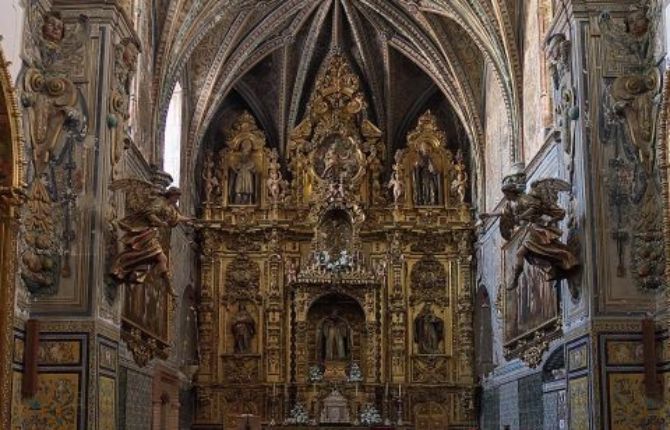
The monastery church features a large retablo that was made by Jose Fernando de Midinilla in the 17th century. The main altar was made by Alonso Cano in 1635. Inside, you’ll find sculptures of John the Baptist and the Evangelist by Juan Martinez Montanes.
This monastery was founded by Dona Ana de Santillan in 1473 for the Jeronimas nuns. Since then, it has been dedicated to the worship of God.
Today, you can visit the monastery and view some of the nuns’ handmade crafts. A visit to the monastery is not complete without purchasing confections from the nuns.
The Nicolo Pisano Portal, the former entryway, is a first step in preserving the monastery complex.
While you are in Seville, visit the Museum of Fine Arts. This is the last of the 50 things to do in Seville. If you’ve only come here once, don’t worry – the third part will be published soon.
You’ll get a heads up when it’s available. If you want to visit more, sign up for our newsletter. Then, you’ll receive a head’s up on the release date.
Afterwards, visit the Museo de Bellas Artes, a museum dedicated to Spanish art. Located in a former 17th-century convent, the museum exhibits pieces dating from the Middle Ages to the 20th century.
The museum houses work by famous Spanish artists, including Francisco de Zurbaran. The collection, however, is largely religious, and many visitors are disappointed.
Address: C. Sta. Paula, 11, 41003 Sevilla, Spain Phone: +34 954 54 00 22
20. Torre del Oro
The Torre del Oro is a dodecagonal military watchtower in Seville, southern Spain. It was built by the Almohad Caliphate to guard the city’s strategic location.
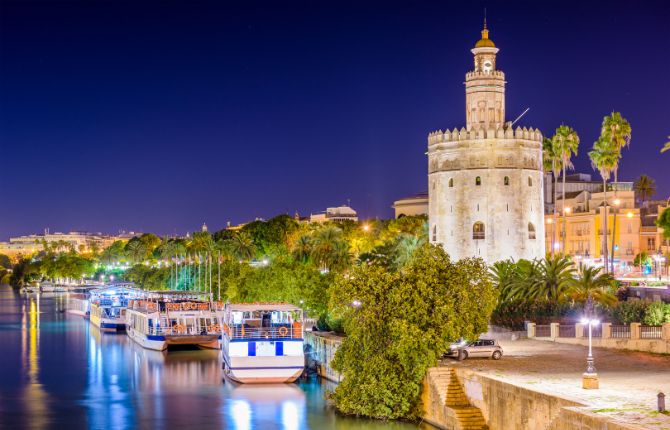
The tower was built to watch the Guadalquivir river and control access to the city. It has been one of Seville’s most popular tourist attractions for over a thousand years.
There are many ways to reach Torre del Oro from Seville. You can catch a bus that leaves every half hour from the central station.
Alternatively, you can take public transport. Buses number 21 and 40 runs along a shaded promenade. You can also take a llama (horse-drawn car) to get around town. In Seville, there is a wide selection of taxis, but they cost a lot.
This historic tower was built by the Moors in the 1200s. It was originally used as a prison and anchoring point for chains that blocked the passageway.
Today, it is an attractive attraction and is a must for any visitor to Seville. The view from the roof is beautiful and well worth the visit. It is located in the Barrio del Arenal and the Barrio de Triana.
The top floor of the Torre del Oro has a naval museum, which exhibits scale models, sailing instruments, diving equipment, and more. The neighborhood of Triana is a wonderful place to visit for fresh and affordable food.
The market has a variety of fresh foods for sale and is very friendly. Be sure to stop by the market on your way down! Visiting this market is a great way to get a taste of local life.
Address: P.º de Cristóbal Colón, s/n, 41001 Sevilla, Spain Phone: +34 954 22 24 19
21. Things to Do in Seville: Archivo de Indias
The Archivo de Indias in Seville is one of the city’s most important historical and cultural landmarks.
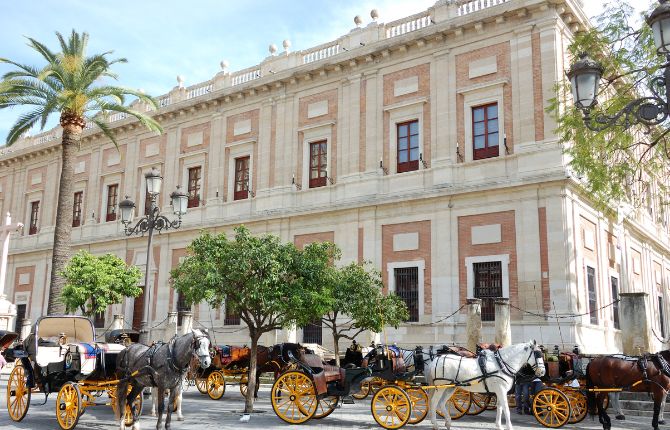
Founded in 1585, the building once housed the Consulate of Mercaderes of Seville and Casa Lonja. In 1785, it became the Archivo de Indias and is the largest repository of Spanish New World documents.
Designed by Juan de Herrera, the building is a clear example of Spanish Renaissance architecture.
The Archivo de Indias in Seville is an extraordinary museum that houses artifacts and maps related to the voyages to the New World. The collection is vast, covering three centuries of Spanish history.
It is an outstanding research resource for anyone interested in the exploration of the New World. You’ll also find a re-creation of Christopher Columbus, a founding father of the city.
Whether you’re interested in ancient Spanish civilizations or modern art, the Archivo de Indias in Seville is well worth a visit.
The Cathedral/Giralda, the Alcazar, and the Archivo de Indias make up the Conjunto Monumental. Together, these landmarks represent the evolution of Spanish urban life and its relationship with the New World.
The Cathedral and the Archivo de Indias, which are both important sites in the city, reflect the Spanish monarchy’s power in the colonies in the New World.
At the heart of the city, the Cathedral houses the tomb of Christopher Columbus, and the ancient Lonja became the home of the Archivo de Indias, which contains some of the most valuable documents relating to the discovery of the Americas.
Address: Av. de la Constitución, s/n, 41004 Sevilla, Spain Phone: +34 954 50 05 28
22. Things to Do in Seville: Metropol Parasol (Setas de Sevilla)
If you’re looking for a unique place to watch the sunset in Spain, you’ve probably heard of the Metropol Parasol in Seville.
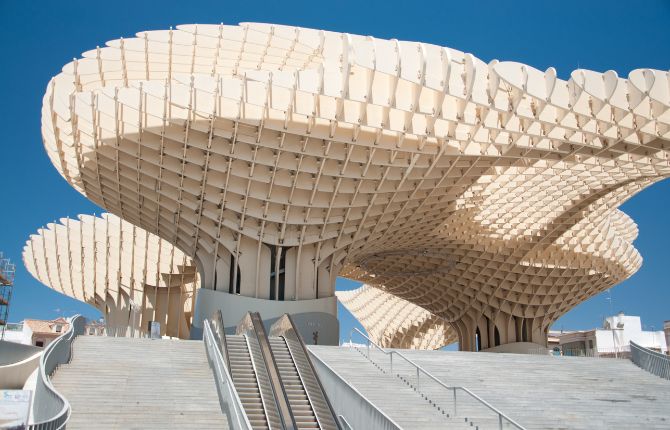
Built over 30 meters tall and made of timber and steel, this structure is unlike anything you’ve seen before. It’s a radically modern structure, contrasting with the old-world charm of Seville.
In addition to the design and construction of the structure, the team consulted experts in fire safety and building services.
Aside from its architectural beauty, visitors to Metropol Parasol can experience the city’s fascinating history by taking a tour of its archaeological remains.
The remains span five thousand square meters and can be viewed in a special exhibition room. There’s also a market located inside the building, and a lookout on top offers fantastic views of the city.
The building’s basement contains ancient Roman ruins, and the entrance fee to the museum is free for residents of the city.
Another popular attraction in Seville is the Alameda district, which is considered the coolest area in town. It has been compared to Soho in London and Barcelona’s El Raval. It has a large pedestrian area with hip bars and alternative restaurants.
You’ll be amazed at the nightlife in this area, and there are even outdoor artisan markets, so it’s a good idea to plan your evening around the Alameda district.
Address: Pl. de la Encarnación, s/n, 41003 Sevilla, Spain Phone: +34 606 63 52 14
Things to Do in Seville
- Seville Cathedral (Catedral de Sevilla)
- La Giralda
- Royal Alcázar of Seville
- Plaza de España
- Parque de María Luisa
- Santa Cruz, Seville
- Triana, Seville (Barrio de Triana)
- Seville Museum of Fine Arts
- Right Bank of the Guadalquivir River
- Iglesia Colegial del Divino Salvador
- Museum of Popular Arts and Traditions, Seville
- Semana Santa celebration in Seville
- Seville Fair (Feria de Abril)
- Museo del Baile Flamenco (Museo del Baile Flamenco)
- Italica, Seville
- Plaza de toros de la Real Maestranza de Caballería de Sevilla
- Casa de Pilatos
- Palacio de la Condesa de Lebrija
- Monasterio de Santa Paula
- Torre del Oro
- Archivo de Indias
- Metropol Parasol (Setas de Sevilla)


